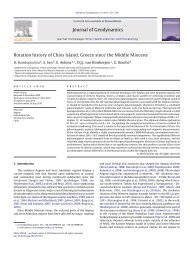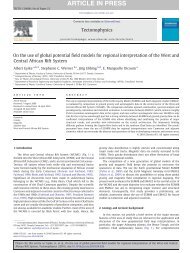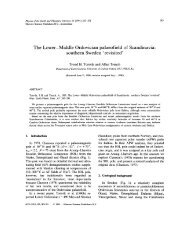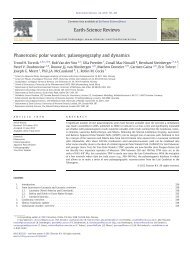SILURIAN MAGNETOSTRATIGRAPHY 825Silurian Palaeomagnetic DataEssential palaeomagnetic and stratigraphic details <strong>of</strong> each <strong>of</strong><strong>the</strong> Silurian data sets displaying single and mixed polarityare recounted below. The stratigraphic positions <strong>of</strong> Silurianpalaeomagnetic data are shown in Fig. 3. Data sets withineach category are discussed in order <strong>of</strong> decreasing number<strong>of</strong> palaeomagnetic sampling sites.Data sets <strong>of</strong> single magnetic polarity(i) Western Ireland sediments, Galway and Mayo,Eire. Smethurst & Briden (1988) describe multicomponentmagnetizations from 39 palaeomagnetic sites within LateSilurian sediments <strong>of</strong> northwest Galway (Salrock Formation)and South Mayo (Clare Island succession), westernIreland. A Silurian magnetization revealed by detailedstepwise-<strong>the</strong>rmal demagnetization predates late-Caledoniandeformation <strong>of</strong> both areas. The Silurian component, termedH, displays an exclusively normal polarity within all sitesyielding stable directions. Unpublished data from <strong>the</strong> latestLlandovery Lough Mask Formation also display normalpolarity (M. A. Smethurst pers. comm. 1992; stratigraphicage after Graham et al. 1989).A Wenlock age is probable for <strong>the</strong> Salrock Formation(Laird & McKerrow 1970). The Clare Island Silurian rocksare probably Wenlock or Ludlow in age (Palmer et al. 1989)and may be contemporaneous with <strong>the</strong> Salrock Formation(Phillips 1974; Smethurst & Briden 1988).(ii) Andesitic lavas, East Mendips lnlier, SW England. Piper(1975) reported initial palaeomagnetic results from four siteswithin andesitic lavas <strong>of</strong> <strong>the</strong> East Mendips Silurian inlier.All samples were subjected to blanket alternating-field demagnetizationto peak fields <strong>of</strong> 50-100 mT. Following tectoniccorrection, <strong>the</strong> lower two sites were regarded as <strong>of</strong>reverse polarity whilst <strong>the</strong> upper two sites were <strong>of</strong> normalpolarity. In resampling <strong>the</strong> sequence (15 sites, 2 in agglomerates),Torsvik et al. (1993) identified two stable magnetizationcomponents during stepwise <strong>the</strong>rmal demagnetization.These magnetizations were attributed Permo-Carboniferous and Silurian remanence ages respectively. Apositive intra-formational palaeomagnetic agglomerate testconfirms <strong>the</strong> primary nature <strong>of</strong> <strong>the</strong> Silurian magnetization.Only normal-polarity Silurian magnetizations were identified.The previous 'reverse' polarity sites <strong>of</strong> Piper (1975)are interpreted by Torsvik et al. (1993) as being Permo-Carboniferous overprints which had been erroneously correctedfor tectonic dip.The interpretation <strong>of</strong> Hancock (1982) suggests that <strong>the</strong>volcanics (in Moon's Hill Quarry) all young to <strong>the</strong> north andare underlain by lower Wenlock shales (M. riccartonensisZone) with probable conformity: <strong>the</strong>y are thus nowconsidered to be Wenlock in age.(ifi) Ainslie Volcanics, Australian Capital Territory,Australia. Seven palaeomagnetic sites from <strong>the</strong> Ainslie volcanicsyielded stable magnetizations <strong>of</strong> normal magneticpolarity (Luck 1973). The sample collection spanned approximately170 m <strong>of</strong> a 210-thick sequence <strong>of</strong> interbeddedacid to intermediate flows and pyroclastic rocks. The rocksuccession is 'mostly sub-horizontal' (Luck 1973). Sampleswere demagnetized to peak fields/temperatures <strong>of</strong>50mT/550°C. Although originally attributed to <strong>the</strong> EarlyPridoliLudlowWenlockLlandoveryLudfordianGorstianGleedonHomerianWhitwellSheinwoodianTelychianAeronian'~"~Wabash Reef(11)~ Hemse Beds(6")~F~_-~-~-~ ~d,a. vo~.i.(6)Ainslie Voleanics(7)Duoro Volcanics (6)Beds (29")Increased ~BloomsburgDominance ! Formation (4) (2)atRingedkeReverseSandstonePolarity (50) (6) (8)(A)(1) / ~ YuejiashanQ I~m~lmlm HuixingshaoSalro~k +Clare IslandSuccession.•(39) (15)MendipMask Fm.U.Visb fH8 klint Beds Volcanics (13)(5) ..m..m~.m~ LoughBotwood King } ~ ' ~~'--"~"~'-~ V OICS + Seals (11)L~'~._'~ George ~',,.~-~,'~Lake 4. \ \ \ \ ] Rose HillArea (11Formation(9): £-'ZZ--3 Lower Trap:Tortworth (1) [~_'~_"~_'~_.](B)KEY"-----] ApproximateStratigraphicLevel & RangeBoth PolaritiesRhuddanianLRed Mountain~ ~ F .... tion (4)[ ]ReverseNormalNo DataFig. 3 Magnetic polarity data for <strong>the</strong> Silurian Period. Individual datasets are discussed in <strong>the</strong> text. Stratigraphic divisions taken from Harland etal. (1990). Numbers in brackets next to each data set indicate <strong>the</strong> number <strong>of</strong> palaeomagnetic sample sites; (those with asterisks refer tonumbers <strong>of</strong> samples). Black, normal polarity; hatched, mixed polarity.
826 A. TRENCH ET AL.Devonian (Opik 1958), <strong>the</strong> volcanics have been re-assigneda Late Wenlock age based upon a revised stratigraphiccorrelation (Owen, in Goleby 1980; Walley et al. 1990).(iv) Douro volcanics, Yass district, New South Wales,Australia. Luck (1973) reports results from six palaeomagneticsites <strong>of</strong> <strong>the</strong> Duoro volcanics following alternating-fielddemagnetization to peak fields <strong>of</strong> 50 mT. All six sites, whichare spread over an area <strong>of</strong> approximately 25 km z, display anormal polarity magnetization. Stratigraphic considerationssuggest a Wenlock age for <strong>the</strong> Duoro volcanics (Packham1969) based upon graptolite faunas (Browne 1954). Anearliest Ludlow age is attributed to <strong>the</strong> overlying YassSub-<strong>Group</strong> (Link 1970; Link & Druce 1972) based upon anabundant conodont assemblage in <strong>the</strong> Cliftonwood Limestone.Luck (1973) also reports a single normal-polarity sitefrom <strong>the</strong> Hawkins volcanics <strong>of</strong> Late Wenlock age (Owen &Wyborn 1979) in <strong>the</strong> Yass area.(v) Upper Visby/HOglint Beds, Gotland, SE Sweden. Fivepalaeomagnetic sample sites (49 samples) within flat-lyingmuddy limestones <strong>of</strong> <strong>the</strong> Upper Visby/H6glint beds, Gotland,carry a characteristic remanence <strong>of</strong> normal polarity(Trench & Torsvik 1991). A conglomerate test failed toyield stable directions <strong>of</strong> magnetization. The characteristicmagnetization unblocks between 250-400 °C/10-35 mT andis carried by magnetite. Although no palaeomagnetic fieldtest is available, extremely low conodont alteration indices(1-1.5; R.J. Aldridge pers. comm.) suggest that visco<strong>the</strong>rmalremagnetization <strong>of</strong> <strong>the</strong> limestones is unlikely tohave taken place. Conodonts in <strong>the</strong> limestones indicate anEarly Wenlock age (Lower Sheinwoodian; Jeppsson 1983).(vi) Hemse and Slite Beds, Gotland, SE Sweden. Followingan extensive sampling <strong>of</strong> Gotland limestones (84 sites),Claesson (1979) obtained stable, normal polarity magnetizations,from only 35 palaeomagnetic specimens. Of <strong>the</strong>se, 29were recovered from <strong>the</strong> Slite beds and six from <strong>the</strong> Hemsebeds. As noted above, remagnetization is considered unlikelybased upon low conodont alteration indices. Thestratigraphic age <strong>of</strong> <strong>the</strong>se units is constrained to LowerWenlock (Upper Sheinwoodian) and Lower Ludlow(Eltonian-Leintwardinian) respectively (Jeppsson 1983).(vii) Lower Trap lava, Tortworth inlier, SW England. Piper(1975) reports a single reverse polarity site (9 samples) from<strong>the</strong> Lower Trap lava at <strong>the</strong> base <strong>of</strong> <strong>the</strong> Damery Beds <strong>of</strong> <strong>the</strong>Tortworth inlier, Gloucestershire (Curtis 1972). Sampleswere demagnetized to peak alternating-fields between 50and 100mT. An Upper Llandovery (Telychian) age is attributedto <strong>the</strong> lava based on fauna from <strong>the</strong> overlyingsediments (Curtis 1972; Zeigler et al. 1974).Data sets <strong>of</strong> mixed magnetic polarity.(i) Bloomsburg Formation, Central Appalachians,USA. Four palaeomagnetic investigations <strong>of</strong> <strong>the</strong> Bloomsburgredbeds have been published to date; namely by Irving& Opdyke (1965), Roy et al. (1967), Kent (1988) andStamatakos & Kodama (1991). We consider <strong>the</strong> results <strong>of</strong><strong>the</strong> latter two investigations here as contemporary demagnetizationprocedures were applied in <strong>the</strong>se studies.Kent (1988) identifies a possible Silurian remanence(component C) from <strong>the</strong> effects <strong>of</strong> Alleghenian remagnetizationat 17 sites around <strong>the</strong> Pennsylvania salient. Thestatistical precision <strong>of</strong> this component peaked at approximately80% unfolding. Stamatakos & Kodama (1991) explainthis 'syn-deformational' peak as resulting from <strong>the</strong>grain-scale deformation <strong>of</strong> a pre-folding remanence. Aprimary remanence-age can <strong>the</strong>refore be contended for <strong>the</strong>Bloomsburg Formation. In Kent's (1988) study, all eightsites from <strong>the</strong> nor<strong>the</strong>rn limb <strong>of</strong> <strong>the</strong> Pennsylvania salientyield consistent normal polarities <strong>of</strong> component C.Conversely, all but two <strong>of</strong> <strong>the</strong> nine sites to <strong>the</strong> south <strong>of</strong> <strong>the</strong>salient display reverse polarity. A similar trend is observedin <strong>the</strong> data <strong>of</strong> Stamatakos & Kodama (1991) in that onlynormal polarities occur on <strong>the</strong> nor<strong>the</strong>rn limb <strong>of</strong> <strong>the</strong> salient(Delaware Water Gap and Montour Ridge localities) butboth polarities are evident in <strong>the</strong> south (Round Toplocality). These differences are likely to result fromdiachroneity in <strong>the</strong> Bloomsburg Formation.Palaeontological evidence favours a Latest Wenlock toEarly Pfidoli stratigraphic range for <strong>the</strong> BloomsburgFormation <strong>of</strong> south Pennsylvania (Berry & Boucot 1970).(ii) Ringerike <strong>Group</strong>, Oslo region, Sou<strong>the</strong>rn Norway.Douglass (1988) reports multicomponent palaeomagneticdata from two stratigraphic sections (A & B) <strong>of</strong> <strong>the</strong> RingerikeSandstones in <strong>the</strong> Oslo area <strong>of</strong> Norway. ConodontAlteration Indices <strong>of</strong> 3-4 (Aldridge pers. comm.) suggestpalaeotemperatures in <strong>the</strong> order <strong>of</strong> 110-300°C (Epstein etal. 1977). These temperatures are linked to a partial remagnetization<strong>of</strong> Permo-Carboniferous age which fails a fold testin <strong>the</strong> area. Principal deformation is most likely EarlyDevonian in age (Ramberg & Spjeldnaes 1978). A dualpolarity,high-temperature magnetization passes a fold testat <strong>the</strong> 95% confidence level. The high-temperature magnetizationunblocks above <strong>the</strong> Curie point <strong>of</strong> magnetite andis thought to reside in specular hematite (described byTurner 1974). Bedding-parallel reversals are observed inboth sections. In section A, <strong>the</strong> magnetostratigraphy (baseto top) is Normal (6 sites)-Reverse (4 sites)-Normal (2sites). In section B, <strong>the</strong> sequence is Reverse (1 site)-Normal(8 sites)-Reverse (2 sites)-Normal (1 site). No correlation<strong>of</strong> sections A and B was attempted.The redbeds <strong>of</strong> <strong>the</strong> Ringerike <strong>Group</strong> overlie marinesediments <strong>of</strong> <strong>the</strong> Steinsfjorden Formation. The transitionfrom marine to non-marine lithologies is believed to occur atclose to <strong>the</strong> Wenlock-Ludlow boundary (Turner & Turner1974; Worsley et al. 1983).(iii) Upper Llandovery-Lower Ludlow sediments, YangtzePlatform, South China Block. Silurian limestones and redsiltstones <strong>of</strong> <strong>the</strong> Sichuan and Yunnan provinces weresampled for palaeomagnetic investigation by Opdyke et al.(1987). Unfortunately, only sites from redbeds providedstable magnetizations. Characteristic magnetizations predateMesozoic deformation <strong>of</strong> <strong>the</strong> provinces. Three stratigraphicsections were studied at Songkan, Rongxi and Hongmiao.Stable magnetizations were obtained from <strong>the</strong> Baisha Formationin <strong>the</strong> Songkan section (1 site, normal polarity), <strong>the</strong>Baisha and Huixingshao Formations in <strong>the</strong> Rongxi section(12 sites, normal polarity) and from <strong>the</strong> Yuejiashan Formationin <strong>the</strong> Hongmiao section (2 sites, reverse polarity).Stratigraphic assignments <strong>of</strong> <strong>the</strong> formations are as follows(Opdyke et al. 1987 fig. 1; based on Lin et al. 1982): Baisha










